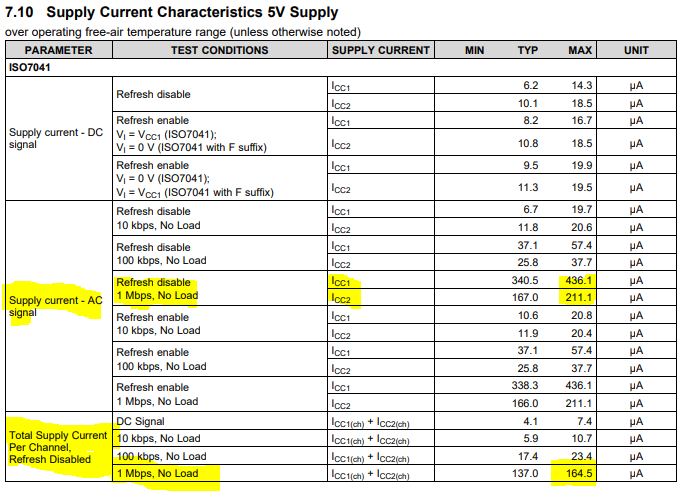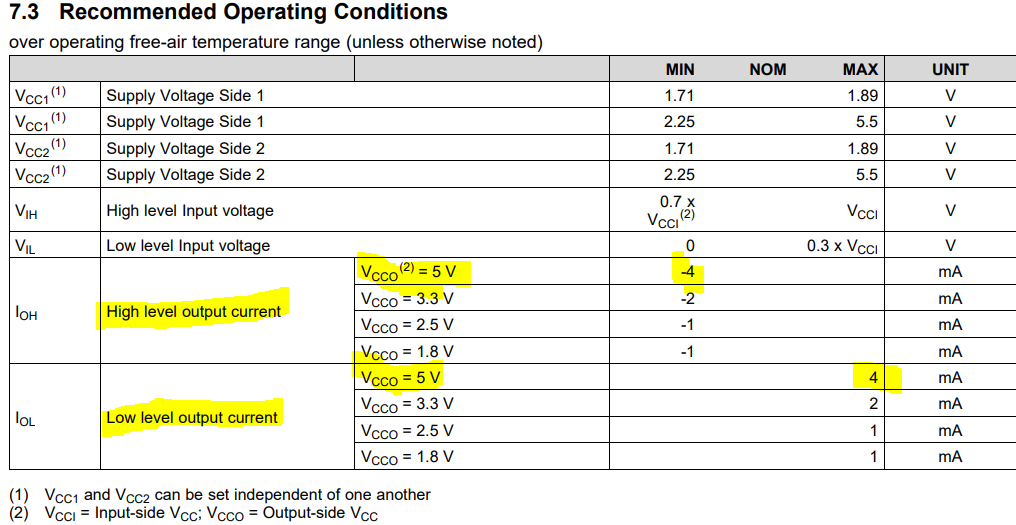- Ask a related questionWhat is a related question?A related question is a question created from another question. When the related question is created, it will be automatically linked to the original question.
This thread has been locked.
If you have a related question, please click the "Ask a related question" button in the top right corner. The newly created question will be automatically linked to this question.
Dear TI Guru,
When VCC1 (Pin1) and VCC2 (Pin16) are un connected in ISO7041, still the currents flow through GND1 (Pin8 ) and GND2(Pin9) though the IO lines at both sides are floating.
The currents are of the order of 2mA & 4mA respectively in the above condition irrespective of EN pins either sides connected to GND or VCC.
And when the VCC1 and VCC2 are given supply of around 5V, the current through pin to pad of pin9 increases by an additional 2mA.
Correct link for the PN = ISO7041 Ultra-Low Power Four-Channel Digital Isolator datasheet (Rev. D) (ti.com)
Thanks in advance for quick help.
Hello Anandteerth,
Thank you for your question. It sounds like you are applying signal to the ISO7041 without powering VCCI. Please know, that if this is what you are doing then it violates the absolute maximum value conditions of the device and may have damaged the device. In general, the signal should not exceed the supply voltages. Here is an FAQ with more information (+) [FAQ] Can a digital isolator signal voltage be different from its power supply voltage? - Isolation forum - Isolation - TI E2E support forums.
If I have understood incorrectly, please provide clarification about how you are testing the device.
Best,
Andrew
Dear Andrew,
In reference to section 7.10 of the data sheet, I was under the impression that ISO7041 consumes less than1mA (164uA *4) when the device is powered up with 5V at both sides with respect to their grounds and when the channels are under No load condition. But looks like the device consumes around 4mA with channels under No load condition and either when VCCs are powered up to 5V in reference to their grounds OR they are open. Hope you got my observation / question.
Hello Anandteerth,
Thank you for the information. Please see my inputs below:


Best Regards,
Andrew
Hello Anandteerth,
Did this resolve your question? If it did, please resolve the thread or let me know if you have any more questions.
Best,
Andrew
Dear Andrew, We have revised the new boards and I do still see that the current ICC1 and ICC2 are around 2mA for the device when the communication is happening. Looks like it is due to the load / active devices either sides. I will investigate further and post the details to you.
Hello Anandteerth,
Thank you for letting me know. I will keep this thread open, and I look forward to your inputs.
Dear Andrew, even if its around 2mA for ICC1 and the same for ICC2, TI can not be questioned, as 436uA and 211uA for ICC1 and ICC2 are under no load condition. Looks like the discussion ends up here with this. Pl. let me know your thoughts on the same.
Hi Anandteerth,
Your understanding is correct, the values specified in the datasheet are all for "No Load" conditions, so the 2mA that you are seeing is most likely due to loading conditions. Whatever the load is, please make sure that it does not cause the device to draw a current >4mA, if this limit is exceeded it could damage the device.
Best,
Andrew
Dear Andrew, Thanks for the reply.
As such, I was not expecting that the ICC increases to the extant of 5 to 10 times when the Loads are connected as the source and sink currents are taken care by the respective source / loads within the specified limits of the Isolator.
Any way, thanks for the confirmation, in line to my findings.